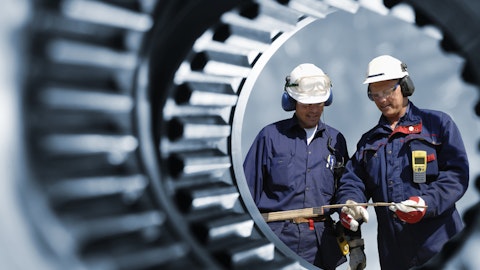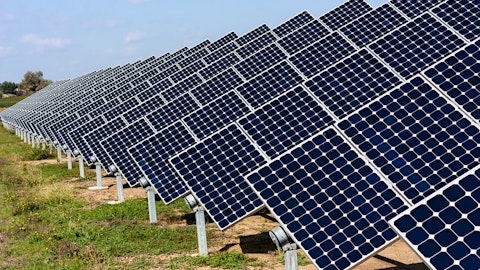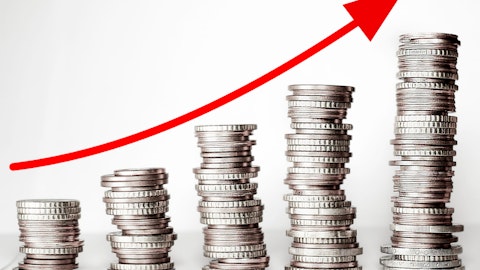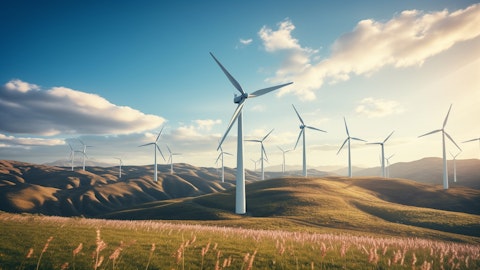Atlantica Sustainable Infrastructure plc (NASDAQ:AY) Q4 2024 Earnings Call Transcript March 1, 2024
Atlantica Sustainable Infrastructure plc beats earnings expectations. Reported EPS is $0.02, expectations were $-0.23. AY isn’t one of the 30 most popular stocks among hedge funds at the end of the third quarter (see the details here).
Operator: Welcome to Atlantica’s Full Year 2023 Financial Results Conference Call. Just a reminder that this call is being webcast live on the Internet, and a replay of this call will be available on Atlantica’s corporate website. Atlantica will be making forward-looking statements during this call, which are based on current expectations and assumptions and are subject to risks and uncertainties. Actual results could differ materially from our forward-looking statements. If any of our key assumptions are incorrect or because of other factors, including the Risk Factors section of the accompanying presentation and in our latest reports and filings with the Securities and Exchange Commission, all of which can be found on our website.
Atlantica does not undertake any duty to update any forward-looking statements. Joining us for today’s conference call are Atlantica’s CEO, Santiago Seage; and the CFO, Francisco Martinez-Davis. As usual, at the end of the conference call, we will open the lines for the Q&A session. I will now pass you over to Mr. Seage. Please, sir, go ahead.
Santiago Seage: Thank you very much. Good morning, and thank you for joining us for our 2023 conference call results. In 2023, we have met the guidance we provided at the beginning of the year, both regarding EBITDA and for CAFD. If we cover briefly some of the achievements during the year, we remind you that in early 2023 we were able to refinance two large assets in Spain, creating long-term value by extending maturities at what — at the time we’re still very reasonable in costs. Additionally, 2023 has been a year where we have continued evolving in our growth strategy, demonstrating that Atlantica can grow through a combination of development and construction of our own pipeline, and through the acquisition of assets whenever we find opportunities with reasonable returns.
In fact, during the year, several new solar assets have reached commercial operation. Additionally, our development team in the U.S. has made very significant progress during the year. At this point in time, we have three new projects, fully contracted and under construction or about to start construction in the Southwest of the U.S., leveraging the IRA. As you all know, North America continues to be our main target geography in terms of new investments, in terms of capital allocation. And finally, in 2023, we have continued finding and moving forward new development opportunities in our key geographies. In fact, our renewal pipeline has increased by 12% versus last year. If now, we look forward and we talk briefly about 2024, we see that as of March 1, we have already committed or earmarked between $175 million and $220 million in new investments, with the majority allocated to solar and storage projects in the U.S. This represents a 60%, 70% of our $300 million investment target.
Additionally, we expect to complement that amount with some targeted acquisitions, as we believe that the current M&A market is constructive in some areas where we believe that we should be able to lock in accretive transactions like the ones we have done in the past. So all in all, at this point in time, we think that the $300 million target is achievable. Finally, together with our partner, we are in the progress of divesting our 30% stake in Monterrey. We consider that, that is a good example of capital recycling opportunities. With that, I will now turn the call over to Francisco, who will guide us through our financial results.
Francisco Martinez-Davis: Thank you, Santiago, and good morning to everyone. Please turn to Slide 4, where I will present our key financials for full year 2023. Revenue remained stable at $1,099.9 million. Adjusted EBITDA was $794.9 million within our 2023 guideline range and showing a 1.7% increase versus 2022, excluding the effect of foreign exchange in our scheduled — unscheduled outage at Kaxu. Regarding cash available for distribution, we generated $235.7 million in 2023, also once again meeting the yearly guidance. On the following Slide 5, you can see our performance by geography and business sector. In North America, revenue increased by 4.9% to $424.9 million in 2023 compared to the same period over last year, mostly due to higher production in our solar assets in the U.S. with higher availability at Solana.
The increase in adjusted EBITDA was lower 3%, mainly due to lower production from our wind assets where we had lower wind resource during the year. In South America, revenue increased by 13% compared with 2022, up to $188.1 million, and EBITDA increased 15.9% to $146.7 million. The increase was mainly due to assets which recently entered into operation and inflation in the indexation mechanisms in our contracts. In the EMEA region, revenue and adjusted EBITDA decreased by 8.2% to $328.9 million, and 8.8% to $26.6 million, respectively. The reduction was mainly due to an unscheduled outage at Kaxu that we discussed in the previous quarter. As a reminder, we expect the insurance policy to cover the impact of business interruption after a 60-day deductible.
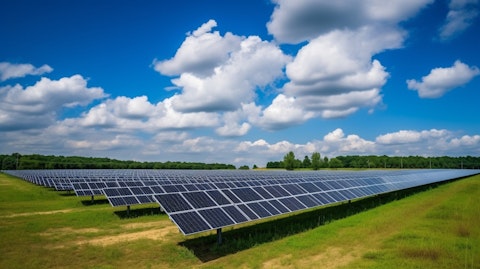
Let’s now please turn to Slide 6, where we will review our operational performance. Electricity produced by our renewable assets reached 5,458 gigawatt hours in 2023, an increase of 2.6% versus the same period of 2022, mainly due to the increase in production in our solar assets in United States and Spain as well as the contribution of recently consolidated assets and those that have entered into operation recently. Looking at our availability-based contracts, our efficient natural gas and heat segment and water segments continued to achieve very high availability levels during 2023. Let me now please turn the call back over to Santiago.
Santiago Seage: Thank you, Francisco. If we take a look at Page 7, and as many of you know, Atlantica targets around $300 million of investments every year. As of early March, and as I mentioned before, we have already invested, committed or earmarked between a 60% and 70% more or less of that target. As of today, we expect to complement that with additional developments that might get into construction during the year, and targeted acquisitions in certain areas. A majority of those $175 million to $220 million are expected to be invested in solar and storage projects that we have already contracted in the U.S., including Coso 1 and Coso 2, and a new project called Overnight. As a reminder, Coso Batteries 1 and 2 are two stand-alone battery projects in California with combined storage capacity of 180-megawatt hours, and both of them have signed PPAs with an investment-grade utility and are currently under construction.
We also expect, as you see there, to invest another $35 million to $60 million in solar and storage projects in other geographies, mostly South America and a bit in Europe. If we move on to Page 8, we highlight there two other projects or the most recent projects, highlighting there a little bit how the portfolio that is starting construction looks like. Overnight, as I mentioned before, is a new 150-megawatt solar PV project in California. Recently, we entered into a 15-year busbar PPA with an investment-grade utility. Under that PPA, Overnight will be receiving a fixed price per megawatt hour with no basis risk, something that, as you all know, we like. We are now busy working on a second phase of the same project that will include storage resulting in a solar plant with storage in California.
But meanwhile, we have contracted the solar part of the plant, and we will be starting construction soon. Another example of new projects, ATS and ATN expansions. These projects are expanding some of the transmission lines we own in South America. And these new investments will be receiving capacity payments with inflation indexation and denominated in U.S. dollars. In summary, a very low-risk contract in what we consider is a very low-risk asset class in geographies where we can find very good returns that, as you know, we like to combine with our investments in North America. Moving to the next page. You can see an update of our pipeline that includes 2.2 gigawatts of renewable energy, and 6 gigawatt hours of storage projects. We continue to focus on North America as our key geography, and we continue to focus on solar and battery storage as our main sectors or technologies.
With that, Francisco will now close the presentation with our 2024 guidance.
Francisco Martinez-Davis: Thank you, Santiago. On the next slide, we’re initiating our 2024 guidance. This year, we expect adjusted EBITDA in the range of $800 million to $850 million, and cash available for distribution in the range of $220 million to $270 million. We’re initiating this guidance with a wider range for CAFD because of four major effects. The proceeds from the potential sale of our equity interest in the Monterrey assets that we expect to close in the first half of 2024. Then scheduled outage at Kaxu. Although we expect insurance to cover the business interruption after a customary 60-day deductible, the outage will affect distributions in 2024. Volatility and electricity market prices in Spain could also affect distributions in 2024.
However, deviations against regulatory prices during this period are to be compensated starting in 2026 according to the regulation. And finally, uncertainty regarding the level of collections at ACT could bring volatility to the 2024 CAFD. And this could have either a positive or negative effect. We expect to be able to narrow the range in the upcoming quarters. With this, let me conclude today’s presentation. Thank you all for joining us. And now, operator, we are open for Q&A.
See also 15 Developed Countries with Citizenship Tests and 15 Countries with the Most Beautiful Castles in the World.
Q&A Session
Follow Atlantica Sustainable Infrastructure Plc (NASDAQ:AY)
Follow Atlantica Sustainable Infrastructure Plc (NASDAQ:AY)
Operator: Thank you [Operator Instructions] Our first question today comes from Nelson Ng with RBC Capital Markets. Nelson, please go ahead.
Nelson Ng: Great. Thanks. I just had a few questions on Monterrey. Can you just — can you give some color on what the proportionate EBITDA contribution was in 2023? [Multiple Speakers]
Santiago Seage: Yes. We can hear you. Good morning first of all. So the EBITDA contribution, as you know, is not a public number. What we can tell you is that, it’s a very small part of the EBITDA.
Nelson Ng: Okay. Great. And then in terms of, I guess, the CAFD bridge that you’ve included. So it includes, I think, $30 million for Monterrey. Can you describe how — or how you came up with $30 million relative to the $45 million to $52 million in proceeds? And I guess, do you generally include sale proceeds in CAFD? And should we expect that going forward?
Santiago Seage: Nelson, I propose that you follow up on this detailed question with IR.
Nelson Ng: Okay. Sounds good. And then one last question on Monterrey, which I can also maybe follow up with IR later. But I think in the notes, you mentioned that you can’t guarantee that the transaction will close. So are there any particularly, like onerous condition precedents or anything? Like is there — is the risk of closing particularly higher for this transaction? Or generally, you expect it to close, but you’re just saying…
Santiago Seage: No. I mean, we do expect to close. And in our disclosure, you will see that what we say is that we expect to close during the first half of this year. There is nothing abnormal or that is not customary in the conditions to close. The only thing is, obviously, we don’t control the timing that’s why we have been cautious in the wording, but we do expect to close.
Nelson Ng: Okay. I just have one last question. On the Overnight solar and potential storage project, I think it could be a pretty large project for you, particularly if there’s also a storage component. Would you be looking at, I guess, retaining 100% of that project? Or would you look to get a partner? I’m just thinking in terms of strategy, but also funding as well.
Santiago Seage: Yes. So at this point in time, what we have contracted, and we will be starting to purchase and build, is the solar component. And at this point in time, our expectation is to retain 100% of the equity. As you know, in the U.S., if you include tax equity financing and back leverage, the amount of equity as a percentage of the total investment, let’s say, is fairly low. If the — if and when the second phase happens and depending on financing, we will obviously be able to consider options like the one you’re suggesting.
Nelson Ng: Great. And what’s the timing for that project? When does the PPA kick in? Or when does the project need to be completed?
Santiago Seage: So the way we have signed the PPA is fairly flexible. So there’s, let’s say, a fairly long window in which we can start operations.
Nelson Ng: Okay. I’ll leave it there. Thank you very much.
Santiago Seage: Great. Thank you, Nelson.
Operator: The next question comes from Mark Jarvi with CIBC Capital Markets. Mark, please go ahead.
Mark Jarvi: Yes. Good morning. Some decent progress towards equity commitments for the year and you’re talking about M&A. How do you think about the funding backdrop right now if you do get to $300 million of equity deployment. And does access to capital at all constrain your willingness to push towards the $300 million in the short term?
Francisco Martinez-Davis: Mark, this is Francisco. I mean, that is a very good question. Well, we expect — as I said, the $175 million to $220 million, these are our commitments throughout the year. So that is spread out throughout the year. So we expect to fund those through a combination of several levers that we have. We have the retained portion of the CAFD that we generate throughout the year. We also have a cash position on hand that we could use towards that purpose. We could have additional drawdowns on our corporate facilities since we are in a position where we could increase our leverage within our target. And then we could also use, as Santiago mentioned to the previous question, nonrecourse debt at the project level.
These are fully contracted assets. So we are looking at a combination of project financing and tax equity. And we have been in active discussions with potential lenders regarding these three projects. And then finally, we mentioned the Monterrey project. As I said, we have some opportunities with regards to capital recycling, and we could put that in the mix also, Mark.
Mark Jarvi: Okay. And then again, if you try to get it to $300 million, though, you think all those tools or those different options would get you there as it stands today? Like there’s no need for equity to get to $300 million of equity deployments this year?
Francisco Martinez-Davis: At this particular stage, we are not going to play with equity, Mark.
Mark Jarvi: Yes. Okay. So the guidance midpoint sort of implies — I know the sale of Monterrey is maybe a onetime item, but even if you’re at the lower end, you’re sort of in that 11% to 12% CAFD yield relative to where the share price is today. I just wanted to check how you guys think about the new hurdle rates for growth? Are you able to get that on projects above where your stock yields versus maybe buying back some shares right now? Just trying to think about hurdle rates, your perception on your cost of capital and capital allocation right now.
Santiago Seage: Both in projects we have developed and are building in M&A., our hurdle rates obviously are higher. At this point in time, we are able to deploy capital with those higher hurdle rates because of the fact that we are under a strategic review, stock repurchase at this point in time is not an option we can consider. Obviously, in the future, it would be an option if the strategic review was not there.
